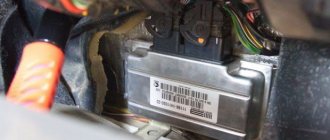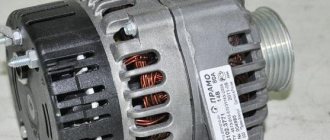In order for the car to work properly and not fail on the road, the car owner must constantly monitor the technical condition of his “four-wheeled friend,” while paying a lot of attention to the car generator. If the unit fails, the battery will not be able to receive electrical recharging, and as a result, the car will work only from recharging the battery, the reserve of which will be enough for a short period of time.
As soon as the battery supply is depleted, the engine will stop functioning and the car will simply stop, anywhere. In this case, the car owner will have to look for a lot of money to purchase a new generator, as well as to check and install it. But the process of monitoring technical serviceability, in which the most important thing is to monitor what voltage the VAZ-2110 generator should produce when driving, will help save money and know that the car will not let the owner down under any circumstances. If you notice that the generator is working intermittently, then you need to check the functionality of the unit, especially since it is quite simple to carry out such a process yourself, taking into account the advice and recommendations of professionals in their field. However, before work, the car owner must familiarize himself with some rules that will help check the serviceability of the unit without damage.
How many volts should the generator produce?
In order for the car to work properly and not fail on the road, the car owner must constantly monitor the technical condition of his “four-wheeled friend,” while paying a lot of attention to the car generator.
If the unit fails, the battery will not be able to receive electrical recharging, and as a result, the car will work only from recharging the battery, the reserve of which will be enough for a short period of time. As soon as the battery supply is depleted, the engine will stop functioning and the car will simply stop, anywhere. In this case, the car owner will have to look for a lot of money to purchase a new generator, as well as to check and install it. But the process of monitoring technical serviceability, in which the most important thing is to monitor what voltage the VAZ-2110 generator should produce when driving, will help save money and know that the car will not let the owner down under any circumstances.
If you notice that the generator is working intermittently, then you need to check the functionality of the unit, especially since it is quite simple to carry out such a process yourself, taking into account the advice and recommendations of professionals in their field. However, before work, the car owner must familiarize himself with some rules that will help check the serviceability of the unit without damage.
Constant undercharging of the battery or its absolute discharge at the most inopportune moment is a headache for many car owners. One source of these problems may be the generator. But how to check it? Perhaps it's not his fault at all? Let's figure out together how much the generator must produce for the normal functioning of all car systems and maintaining the battery in a charged state.
It is traditionally believed that 13.5-14.5V should be supplied by the generator to the battery and this is absolutely enough to replenish the battery costs.
It is worth considering that using a battery with a higher power in a car than the manufacturer recommends also requires the installation of a more productive generating device.
It is necessary to take into account the load that the generator must withstand - it is calculated based on the maximum indicators of all electrical appliances and car systems.
Do not forget that the charging current from the energy-generating device will allow you to start the car in the cold season. In order to avoid problems with starting the car, we recommend purchasing generating equipment, the charge current of which will be approximately 10% of the capacity of the power source.
That is, a battery of 100 A/h requires a generator that can produce 10A. Please note that for many cars, 100 amp equipment will operate at its maximum capacity, because the power consumption of the automotive system is in the region of 80 amps. Therefore, the choice of a source generating energy must take into account both the battery capacity and network consumption.
The potential difference can be diagnosed in two ways - directly at the generating equipment and through the battery. The generator is directly connected to the power source with a thick wire, therefore, to check the level of potential difference, you can measure the voltage at the power source. To do this, you will need special devices - a voltmeter, multimeter or load plug.
The wires of the first measuring instruments are connected to the battery in any sequence. The plug must be connected to the battery terminals with strict observance of polarity. It is generally accepted that the normal voltage in the network should not be lower than 12 volts. At idle speed without turning on all the electrical appliances of the car, this indicator should be at the level of 13.5-14V. A drop in voltage values to 13.3-13.8 volts is considered acceptable.
At the same time, using conventional testing equipment, you can check the resistance of the generator elements - rotor, stator and diode bridge. Diagnostics of rotary equipment is carried out by its winding. It is necessary to connect the probes of the device with slip rings. If the multimeter gives readings from 2, 3 to 5.1 ohms, then this element is working. The current consumption of the winding should be within 3-4.5 amperes.
Its normal resistance is 0.2 Ohm. The diode bridge is checked by the presence or absence of resistance, the indicators do not matter. The only thing worth considering is that there should not be a zero dimension. Measurements are carried out in pairs - positive output and all plates on this side or minus and all elements.
We remind you that for normal charging of a car battery, the voltage supplied by the generator must be from 13.5 to 14 volts.
For correct operation of the car, it is necessary to regularly check the functionality of the car generator. If this unit fails, the battery will no longer receive main power. This state of affairs (when the car is “powered” only by the battery) leads to a rapid loss of power to the entire car.
Timely monitoring of the technical condition of the electrical source will allow you to avoid accidental failure of the element, saving your money and mental strength.
The breakdown of the power unit generating current is determined by one of the following signs:
- The light on the dashboard is constantly on (signal of insufficient current);
- The battery constantly runs out;
- electrical equipment malfunctions or does not work at all when the engine is turned on;
- burning smell from the engine compartment;
- the stator overheats;
- The NODE makes uncharacteristic sounds (for example, rustling).
What does engine speed affect?
Having figured out what voltage the car generator produces, it remains to determine the current, which directly depends on the armature speed. It should be taken into account that any generator has a current limitation and cannot produce more, no matter how much rotor speed increases. Thus, according to current indicators, 3 modes can be distinguished - minimum, rated and maximum current.
The minimum indicator is the current at idle speed of the engine (usually 1500-1800 rpm) and it (minimum current) should be 40-50% of the nominal value. The rated current is an indicator at which the generator components heat up within acceptable limits. In this case, the rated current is close to the maximum. It is this indicator that is indicated in the passport data of the device and on the body of the generator itself. For domestic models of generators, the rated current is achieved at 500 rpm.
When choosing a generator, you should not be guided by what voltage the car’s generator should produce, since it is the same for all models. The main indicator is the rated current of the generator, which should correspond to 200% of the battery capacity with a small tolerance of 10-15%. It is also not recommended to install a larger capacity battery on the car, since it will not sufficiently restore the charge from the alternator already in use.
Step-by-step check of the car generator regulator
The basic rules used when checking the generator voltage are simple, but mandatory for all car owners without exception:
- Under no circumstances should the functionality of the generator be tested using a so-called spark, that is, using a short circuit;
- It is not allowed to connect the device to the generator terminal “ ”;
- Welding work cannot be carried out in the body of the car if the wires are connected to the battery and generator.
It is important to consider the following points when checking voltage:
- measurements are carried out using special instruments called a voltmeter and an ammeter;
- checking the valves of the device is permitted if the voltage does not exceed 12 V;
- If the voltage test requires replacement of the wiring, you need to select identical wires both in cross-section and in length.
Before starting the test, make sure that all connections are working properly and that the device belt tension is correct.
It is not difficult to check what voltage a VAZ-2110 car generator should produce if the test is carried out in stages, and the car owner takes into account the advice of experts:
- Initially, you need to start the car engine, selecting medium speed and turn on the headlights. The car should remain in this mode for about 20 minutes. The indicator, as mentioned earlier, is measured with a voltmeter, the measuring scale of which is from 0 to 15 V, or with an ammeter.
- The voltage between the generator input “ ” and the mass of the unit is determined. If the generator is working properly, the indicator on the device scale should not exceed 14.5 V. If the device data is higher or lower than the established norm, then most likely you will have to replace the failed regulator.
- You can measure the voltage in another way, in which a voltmeter is connected directly to the battery. However, the resulting indicator will be accurate only if the car wiring is completely intact.
- You can also check the voltage using a special lamp, which is located on the dashboard; it is called a “control device”. In the time interval between turning on the ignition and starting the engine, the control light should be on, which allows you to control the voltage of the generator. If, when starting the engine, the lamp goes out and does not light up again, this will indicate that the generator is operating normally, without interruptions.
How to increase?
A drop or too low voltage on the on-board network can be due to various reasons. Before increasing the network voltage from 5 to 12 Volts, you need to make sure that the car generator is functioning normally. If the energy loss is due to improper operation, then it is necessary to dismantle and repair the device, replacing the failed mechanisms with new ones.
Often this parameter drops due to a discharged battery, then perhaps it makes sense to diagnose it - check for cracks, replace the electrolyte, or. In terms of charging, certain points must be taken into account - the procedure must be carried out using only a working charger in compliance with all the rules and nuances. These points are described in detail in the article.
Installing a diode in the generator circuit
If the indicator in the electrical circuit drops, but this is not related to the operation of the generator or battery, then you can increase it on your own. The task is to “deceive” the generator regulator and make it “think” that the car’s on-board network has an even lower voltage than it actually is. Having done this, the generator device will replenish the necessary power reserve; to complete this task, a diode must be added to the power circuit of the unit. In particular, it should be installed as shown in the photo.
Before you increase the voltage that is falling, keep in mind that it is important to maintain polarity when installing the diode. If the polarity is reversed, nothing will happen, but the node will not be able to provide the required charge. Note that the diode must be designed for a current of at least 5 Amps
Since the diode will heat up during operation of the generator unit, it would be optimal to mount it on a radiator
Note that the diode must be designed for a current of at least 5 Amps. Since the diode will heat up during operation of the generator unit, it is optimal to mount it on a radiator.
When choosing a diode element, one nuance must be taken into account - for germanium parts, the voltage drop will be about 0.3-0.7 volts, and for silicon parts - from 0.8 to 1.2 volts. This is exactly the value by which the voltage in the electrical circuit will increase. Take this point into account when choosing, it will determine the final result. If the voltage in the on-board network drops to 1.2 volts, and you use a boost diode of 0.3 volts, then there will be little point in increasing the power of the on-board network.
When installing the diode element, it is necessary to ensure that the wire from it is not installed under tension; this will not be entirely convenient. The best option would be to increase the cable length by approximately 2 centimeters from the diode. This will make it easier to install it into the voltage relay connector of the generator device, and if dismantling is necessary, it will be easier to do.
Loading …
Troubleshooting
A lot depends on the operation of the VAZ 2110 generator. If it malfunctions, what can start the battery? And when it stops providing the required voltage, you have to urgently figure out what the reason is. But just by external signs you can determine that the generator is creating problems:
- The charging light starts flashing at low speeds;
- there may be a burning smell in the cabin;
- there are mechanical damages.
If a visual inspection does not bring results, you must:
- remove the plastic cover from the generator;
- check all electrical connections;
- Unscrew the diode bridge, as well as the voltage regulator relay with brushes.
Diodes are checked with a special tester. When they operate normally, the current will only flow in one direction. If the current flows in two directions or the diodes do not pass it at all, then the reason has been found.
The cause of poor performance may be the belt. If it is worn out, it can be seen immediately. If the generator winding “flies”, it is better to entrust the solution to this problem to a specialist.
Functions performed
So, what is a generator for? First of all, in order to provide all VAZ 2110 equipment that runs on electricity with energy. Perhaps someone thinks that this is the battery's task. Not really, because the battery is needed to maintain functionality when the engine is not running (it starts the engine, supports the alarm, music system while parked, etc.).
But when the engine has already started, with the help of the battery, the generator comes into play. During the trip, it is he who supports the operation of all electronics, air conditioning, audio (or even video systems), and everything else that you have added to your VAZ 2110.
Another equally important function of the generator is charging the battery. This also happens when the engine is running. And if it weren’t for this device, the battery would not be able to cope with its tasks, and it would have to be charged all the time.
Considering that today on the VAZ 2110, in addition to the standard layout, many additional energy consumers are installed, it happens that the generator voltage is not enough. In this case, it makes sense to install a 120 amp generator.
Signs of a generator malfunction
What could be the problem with the generator when, when you turn on the ignition, the light flashes or does not turn on at all and the control devices do not function? You should check to see if the fuse located in the mounting block is ok. If there is a break in the power supply, the following may occur:
- the “O” wire with the wires from the mounting block to the devices is broken;
- there was a breakdown of the “GP” wire with the wires from the ignition switch to this unit.
If the battery is discharged, the generator voltage will not give the desired figure.
And the reason may lie in the fact that the control lamp has burned out, or perhaps the socket contacts are not pressed sufficiently against the printed circuit board. In this case, the lamp or faulty contacts are replaced.
You should look to see if there is an open circuit in the circuit connecting plug “D” of the generator and the devices. If this is exactly the case, then you need to look at the “KB” connections.
A lot also depends on the brushes if the VAZ 2110 generator does not produce the required power. They can wear out, freeze, the contact rings can oxidize, then you need to replace the entire brush holder along with the brushes. Oxidized parts are wiped with gasoline.
The terminals of the generator winding may become unsoldered from the slip rings, which need to be soldered or the surface of the generator rotor should be leveled.
A short circuit may occur in the valves, and the rectifier will have to be replaced. If the generator is noisy, it means there is a breakdown - the bearings are damaged; If the generator makes too much noise, you need to check the stator.
But when the generator 2110 does not produce 14.2 V, as it should, you need to start the engine - let it run for a while. In a few minutes, pressing the gas pedal, you need to increase the crankshaft speed to 3000 rpm. Now all functions should work, after which the voltage at the battery terminal is measured.
How to determine the lack of battery charge on a VAZ 2105
The easiest way to determine the lack of charging is using the car’s instruments, that is, the charging indicator lamp and the sensor (voltmeter) on the instrument panel. The sensor arrow should be in the green sector, and the battery lamp should not light up when the engine is running. Otherwise there is no charging.
But the best way is to check the voltage on the battery with a multimeter. When there is a charge, the voltage on it lies in the range of 13.6-14.2 V, and when there is no charge, it will only have its own voltage of 12 V (± 0.6 V). Under no circumstances remove the terminals from the battery to check to avoid damage to the RR, ECU and other electronic devices on your car.
To troubleshoot battery charging problems, you must use the following tools:
- control lamp 12 V;
- multimeter with a measuring range of up to 60 V AC and DC voltage;
- flat blade screwdriver;
- shaped screwdriver with a Phillips blade;
- pliers;
- knife;
- emery cloth.
How much should the generator produce to properly charge the battery?
The battery in a car is an important element of the system, which is responsible for providing the car’s on-board network with electricity. The generator is used to charge the battery while it is active. Unstable operation of a device generating electricity causes a voltage drop in the network and failure to restore the capacity of the power source.
Normal generator performance means timely and complete replenishment of the battery charge level, which decreases under load. Checking the battery charge level from the generator is simple and can be done by the car owner himself.
Diagnostics of an automotive energy-generating device includes a visual inspection of the unit, its elements and related parts, as well as voltage and current measurements. At least twice a year, you should check the tension of the drive belt, excessive weakening of which leads to a decrease in the performance of the generator, and sometimes can lead to breakdown of the device.
Diagnostics of indicators such as voltage, current, resistance are also necessary twice a year. To carry it out, you will need special devices - a voltmeter, multimeter or load fork.
Other causes of low voltage
A small potential difference in the system is not always associated with a breakdown of the generator or a bad battery. If the diagnosis of these elements does not reveal any problems, then you should pay attention to the following:
- condition of the battery terminals - connection density and oxidation;
- electrical wiring problems - oxidation, violation of its integrity;
- output contacts to electrical appliances;
- correctly selected energy consumers.
Each contact must be tightly adjacent and intact, that is, there must be no formations (for example, sulfation) that will disrupt the flow of current. Incorrect connection of contacts leads to accelerated battery discharge even when the car is not running.
To improve the connection of the elements of the car's electrical system, it is necessary to clean all contacts and restore the integrity of the wires by replacing them or connecting them and wrapping them with insulating tape.
In conclusion, I would like to repeat that stable operation of the car requires constant monitoring of all elements, and the generator should attract special attention. The battery is charged from it and provides electricity to the entire car system. Pay attention to all elements: generator brushes, slip rings, voltage regulator, equipment winding.
The most correct measurements should be carried out when the battery is fully charged and in various modes. Remember that the manufacturer links the characteristics of the generator to the number of engine revolutions - they help produce a certain current.
Do you have experience diagnosing an alternator and solving problems in a vehicle's electrical system? Please share your experience and opinion with our readers in the comments. If you have questions about the topics covered, we will be happy to answer them.
If the symptoms described below appear, carry out diagnostics. You can do it yourself or take the car to a car service. To determine the cause of the failure, special equipment is needed. If you decide to figure it out yourself, master a multimeter tester.
Five possible sources of difficulty are described below:
- bearing wedge (lubricant is used up, sometimes the belt breaks - you will need to replace or rebuild the unit);
- the winding has burned out (a common cause is the reagents used to treat winter roads);
- brush wedge (cause - wear of graphite cores);
- the regulator relay is faulty (this element prevents the battery from overcharging and stabilizes the voltage);
- The diode bridge is broken.
Possible problems
Is your car battery not charging from the alternator even though the car is used regularly? There are many reasons for this. Let's take a closer look at those that motorists most often encounter.
The generator works but does not charge the battery
The battery icon, glowing red on the dashboard when the car is moving, indicates that due to a combination of circumstances, the battery has stopped receiving energy from the generating device. That is, the generator works, but for some reason does not charge the battery. The root cause may be hidden both in the generating device itself and in the battery. Initially, you should determine the reason for the current leak, and in addition, measure the voltage at the terminals, check the level and density of the electrolyte, which in most cases will allow you to identify the culprit of the malfunction. Usually the reason is as follows:
- Burnt fuse. When this happens in the battery circuit, charging will not go directly to the battery; the remaining electrical consumers of the car will operate as normal. In addition, the voltmeter will show the presence of voltage in the on-board network.
- The generator belt is broken or its tension is loose. In such a situation, under load, the generating device will “slip”: the belt slips on the pulley, making whistling sounds. When the headlights are turned on, the indicator on the panel indicating that the battery is low will light up. Eliminate the cause of the malfunction by replacing the belt, adjusting its tension.
- Damage to contacts or wiring. Oxidized battery terminals contribute to current leakage and do not allow the battery to accept charge from the generator. The condition of the contacts should be checked not only on the battery itself, but also on the generating device, as well as on the vehicle’s ground. The oxide is removed by cleaning or with a special lubricant. The generator is connected directly to the battery with a thick wire. If it is damaged or has manufacturing defects, the battery will not be charged.
Charging "jumps"
Sometimes the generator charging current can fluctuate over a wide range. This affects not only the full supply of energy to the battery, but also other consumers: dim headlights, the interior light bulb blinks, the radio operates intermittently. The main reasons for the instability of the amount of incoming charge:
- The generator regulator is faulty. The device, which is a relay, must ensure the voltage of the on-board network is within acceptable limits, regardless of the load, temperature conditions, and shaft speed. The sensor device is nothing more than a conventional electronic circuit with outputs to graphite brushes. Equipment malfunction may be caused by:
- poor contact between wires or a break in the electrical circuit;
- incorrect adjustment;
- short circuit between contacts;
- sintering of contacts, breakage of the armature spring. Damage to the device usually manifests itself in a regular lack of battery charge or, conversely, its excess. You can check the device's functionality using a tester set to voltmeter mode.
- Failure of the diode bridge. The structural element of the generator performs the functions of a collector, replacing it. A bridge circuit is necessary to equalize the ripple of alternating current and convert it to direct current. The main factors leading to failure:
- problems with the battery - low electrolyte density or short circuit of its cans;
- incorrectly performed “lighting” from another car;
- dirt or moisture that has penetrated inside the generator housing.
Signs of malfunction:
- instant discharge of a fully charged battery;
- the appearance of whistling sounds from under the hood when starting the engine or while driving;
- a steering fault is displayed on the display and the power steering stops working;
- headlights dim quickly when driving;
- The car radio and air conditioner turn off.
In addition, there are several situations when the battery will be discharged intensively, but this is not associated with malfunctions in the generator-battery system:
- The battery is reaching the end of its factory life.
- Rare trips over short distances with a full electrical load - the maximum number of consumers is turned on: headlights, radio, air conditioning, and so on.
- Standing idle in traffic jams for many hours with the engine running.
Important points
The voltage (U) and capacity of the car battery are the main parameters that need to be paid attention to when choosing and checking a power source.
The main purpose of the battery is to start the engine during the period when the car's generator has not yet been connected to work, and the battery is the only power source.
To eliminate operational problems, the car owner should know the following points:
- What does the battery life depend on?
- What should the voltage be (in normal mode, after starting the engine and under load);
- What causes the decrease in capacity during the cold season and other issues.
Let's consider these questions in detail.
We increase power with our own hands
The voltage regulator should not allow values to drop below 13.8 Volts. Such indicators can be achieved using an additional diode, which is included in the electrical circuit. This element is not used in the on-board network at normal values.
If there is not enough electricity, then to activate the diode it is enough to turn on the toggle switch. With the help of such manipulation, the voltage regulator is deceived.
When choosing and installing a diode, you need to consider the following important points:
- the device must produce at least 5 Amperes;
- strictly observe polarity when connecting;
- this element must be placed outside the generator to prevent it from overheating;
- It is better to choose the silicon version of the diode.
To complete the work you will need:
- terminals with male-female wires;
- heat shrink insulation;
- diode.
First, connect the terminals to the diode ends. Solder the “mother” terminal to the negative terminal (cathode) with a strip on the body, and solder the “male” terminal to the positive (anode) terminal.
Place the resulting structure inside the heat shrink tube.
Connect the device to an electrical circuit. Connect the negative “female” terminal to the relay-regulator, and insert the positive wire with the “male” terminal into the diode bridge connector.
Having completed the above steps, you need to assemble the circuit to the end and check the electrical parameters when the generator is running. As practice shows, this method, despite its simplicity, is distinguished by its reliability and reliability.
What determines the shelf life of a battery?
Each manufacturer, after manufacturing a battery, sets a warranty period for its operation.
In addition to this parameter, there is an actual period that depends on many factors - timeliness of maintenance, compliance with operating rules, condition of electrical wiring and other points.
Due to the fact that battery maintenance conditions differ, the shelf life of the product also differs.
Car owners who use their car only in the warm season have the longest battery life. It's another matter when you need a car all year round, regardless of the outside temperature.
In such a situation, the battery life is reduced. This is also due to the fact that in the second case the driver can cover more kilometers.
The battery life is also affected by:
- Serviceability and correct operation of the generator and voltage regulator.
- Connecting additional equipment with a large rated current to the vehicle's electrical wiring.
- Operating mode. The batteries that last the least are those in taxis that travel a long distance throughout the year. In addition, such cars operate in frequent engine starting mode, which puts a load on the battery and generator. If the vehicle is actively used, the service life of the power source does not exceed 1.5 years.
Under normal operating conditions, when the car owner regularly checks the battery and carries out maintenance, the battery life is 4-5 years with a total mileage of 60-80 thousand kilometers during this period.
To avoid problems, it is advisable to periodically check the voltage of the generator and battery.
But the mentioned service life is not the highest, because with careful maintenance the battery can last up to eight years.
But you should know that sooner or later the battery will need to be replaced, because from the moment you start using it, the working plates gradually wear out. The more charge and discharge cycles a battery goes through, the faster it breaks down.
Practice shows that the key role is played by the generator, its serviceability and current voltage. That is why this aspect needs to be given key attention.
Useful tips
- It is not advisable to use the capabilities of the on-board PC to measure the voltage on the battery. The result will differ from the true value due to the specifics of connecting the computer to the on-board network. Therefore, errors cannot be avoided. And approximate data, taking into account some variation in parameters, will tell the car owner little.
- This is how you can verify the normal operation of the generator and the good condition of the battery. Turn off all consumers and start the engine. What voltage should be depending on this is a sign that the battery is 100% charged. The multimeter should show about 13.6±1. Then, one by one, one of the electrical network devices turns on. For example, headlights, then low beam. Each of the electrical devices “reduces” the voltage by 0.2. But in total - no less than 12.8. Otherwise the battery will drain quite quickly.
- Even if the battery meets all the described requirements, a comprehensive check should be carried out regularly. A good battery should “hold” voltage. If the car has not been used, and, for example, after a few days the multimeter shows a value significantly lower than in the previous test, then the battery is already “at its limit.” You need to be especially careful with her.
The author draws attention to the fact that all recommendations are rather approximate and generalized. But it is precisely these simple techniques that allow even inexperienced car owners to understand the condition of the battery, whether the generator is working and how correctly the battery is being recharged. For a more detailed study of all components of the on-board electrical network, you need to contact specialists.











